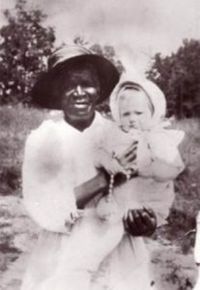Julia Greeley facts for kids
Quick facts for kids Servant of GodJulia Greeley OFS |
|
|---|---|

Julia Greeley and unknown baby
|
|
| Born | c. 1833-48 Hannibal, Missouri, U.S. |
| Died | 7 June 1918 Denver, Colorado, U.S. |
| Resting place | Mount Olivet Cemetery Wheat Ridge, Colorado, U.S. |
Julia Greeley (born around 1833-1848, died June 7, 1918) was an amazing African-American woman. She was once enslaved but later became known as Denver's "Angel of Charity." This was because she helped many families who were struggling. She was also a Catholic and a member of the Secular Franciscans. Today, people are looking into making her a saint.
Contents
Julia Greeley's Life Story
Early Life and Freedom
Julia Greeley was born into slavery in Hannibal, Missouri. When she was about five years old, she suffered an injury to her right eye. This injury stayed with her for her whole life, and some people called her "one-eyed Julia."
In 1865, Julia became free. This happened after the American Civil War. Even though the Emancipation Proclamation freed many enslaved people, Missouri was a "border state." This meant it had to make its own laws to end slavery.
Moving to Denver and Becoming Catholic
After gaining her freedom, Julia Greeley moved to Denver, Colorado. In 1879, she started working as a cook and nanny for a woman named Julia Pratte Dickerson. This woman later married William Gilpin, who was the first governor of Colorado Territory.
On June 26, 1880, Julia Greeley was baptized into the Catholic Church at Sacred Heart Church in Denver. She became very devoted to her faith. She especially loved the Most Sacred Heart of Jesus, the Blessed Virgin Mary, and the Holy Eucharist. She even received Holy Communion every day.
Even though she secretly had painful arthritis, she worked hard. She walked around the city, giving out religious books to both Catholics and non-Catholics. In 1901, Julia joined the Secular Franciscans. She stayed an active member for the rest of her life.
An Angel of Charity
Julia Greeley spent most of her time helping others and doing church duties. After the Gilpin family passed away, Julia started doing labor work for wealthy families. She used the money she earned to help people in need.
She would pull a red wagon through the streets of Denver after dark. In this wagon, she carried food, coal, clothing, and groceries. She delivered these items to families who were struggling. She made her deliveries at night so that white families would not feel embarrassed to accept help from a poor, Black woman.
One time, she even gave up her own burial plot for an African-American man who had died. He was going to be buried in a pauper's grave, which meant a very simple, unmarked grave for poor people. Julia would not let that happen. Because of her great kindness, many people started calling her the "colored angel of charity." She was officially known as "Denver's Angel of Charity" for all her dedication to helping families in poverty.
Her Final Days
Julia Greeley passed away on June 7, 1918. Her body was placed in Loyola Chapel. This was a very special honor, as it was the first time a Catholic person who was not a priest or nun had been honored this way in Denver. She was then buried in Mount Olivet Cemetery.
Julia Greeley's Legacy
Steps Toward Sainthood
In January 2014, the Archdiocese of Denver officially began to investigate Julia Greeley for possible sainthood. This means they are looking into her life to see if she could become a saint.
Julia Greeley is one of a few African Americans whose lives have been looked at for sainthood in recent years. In 2017, her body was moved to Denver's Cathedral Basilica of the Immaculate Conception. She was the first person to be buried there since the cathedral opened in 1912.
As of May 2021, her official investigation was accepted. A special document called a positio is now being written. This document will summarize her life and why she should be considered for sainthood.

